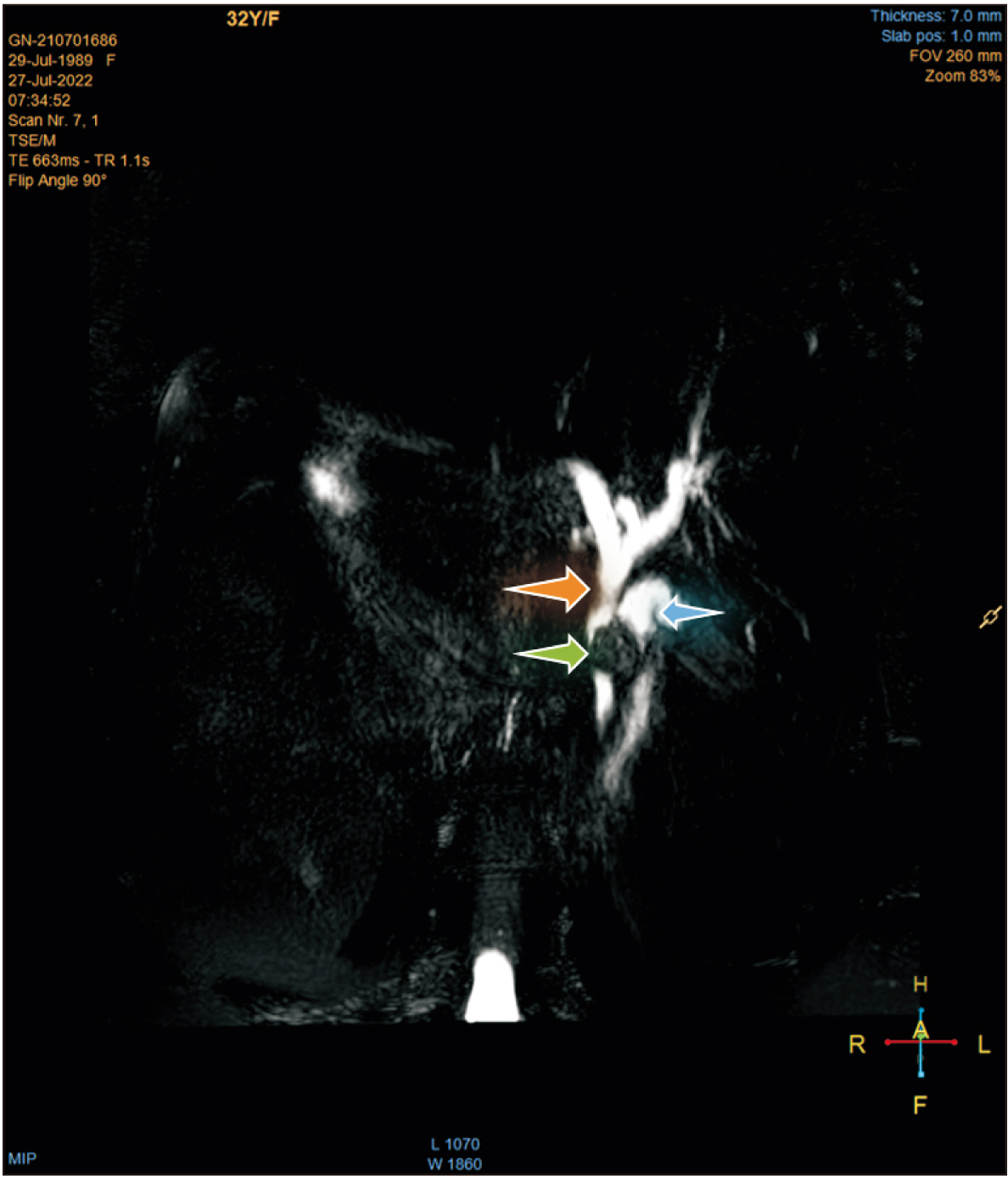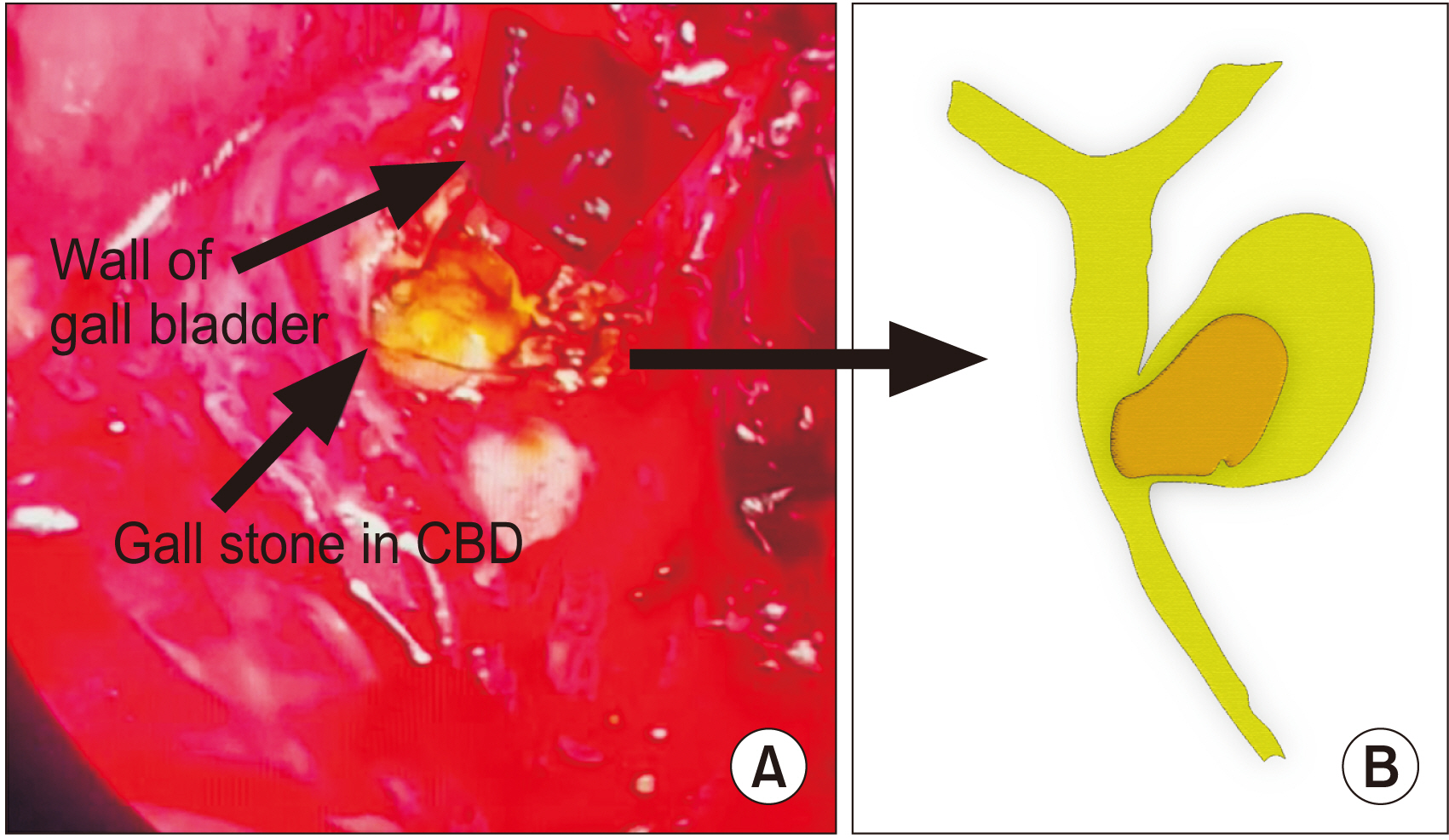Ann Hepatobiliary Pancreat Surg.
2023 Aug;27(3):322-327. 10.14701/ahbps.22-138.
A rare case report of Mirizzi syndrome type III treatment algorithm in situs inversus totalis, large ventricular septal defect and transposition of great arteries in a young diabetic patient
- Affiliations
-
- 1Department of Laparoscopic & Bariatric Surgery, Aster Ramesh Hospitals, Guntur, India
- 2Department of Cardio Thoracic Vascular Surgery, Aster Ramesh Hospitals, Guntur, India
- 3Department of Radiology, Aster Ramesh Hospitals, Guntur, India
- 4Department of Pharmacy Practice, Vignan Pharmacy College, Vadlamudi, Guntur, India
- KMID: 2545781
- DOI: http://doi.org/10.14701/ahbps.22-138
Abstract
- Situs inversus totalis (SIT) is a rare condition in which cardiac and abdominal organs are inverted from their normal left-sided orientation. Mirizzi syndrome, characterized by the obstruction of the common hepatic duct or the common bile duct by gallstone, is a rare condition. Mirizzi syndrome co-occurrence in SIT patients is rare. Gallbladder in sinistroposition is extremely uncommon in SIT patients. We report a known case of diabetes, ventricular septal defect with transposition of the great arteries in a 32-year-old female who presented with jaundice, cholangitis, chills, and fever that had lasted for 10 days. She was confirmed to have SIT with type III Mirizzi syndrome following a series of diagnostic procedures. Primarily, endoscopic retrograde cholangiopancreatography along with common bile duct stenting was performed to initially reduce cholangitis. After an eight-week follow-up after the reduction of cholangitis, surgery was conducted. Mirror-imaged ports were used for the laparoscopic procedure, and the surgeon was on the patient’s right side rather than the usual left side. The patient was discharged from the hospital following two days of uneventful healing.
Keyword
Figure
Reference
-
1. Eitler K, Bibok A, Telkes G. 2022; Situs inversus totalis: a clinical review. Int J Gen Med. 15:2437–2449. DOI: 10.2147/IJGM.S295444. PMID: 35264880. PMCID: PMC8901252.2. Jones MW, Ferguson T. Mirizzi syndrome [Internet]. Available from: https://www.ncbi.nlm.nih.gov/books/NBK482491/. StatPearls Publishing;2022. cited 2022 Dec 15.3. Bose B, Sarkar S, Pal B. 2021; Laparoscopic cholecystectomy and choledocholithotomy and T-tube drainage in Mirizzi's syndrome type I in a case of situs inversus totalis. J Indian Med Assoc. 119:72–74.4. Dakkak W, Oliver TI. Ventricular septal defect [Internet]. Available from: https://www.ncbi.nlm.nih.gov/books/NBK470330/. StatPearls Publishing;2022. cited 2022 Dec 15.5. Martins P, Castela E. 2008; Transposition of the great arteries. Orphanet J Rare Dis. 3:27. DOI: 10.1186/1750-1172-3-27. PMID: 18851735. PMCID: PMC2577629.6. Supriya G, Saritha S, Madan S. 2013; Situs inversus totalis - a case report. IOSR J Appl Phys. 3:12–16. DOI: 10.9790/4961-0361216.7. Leopardi LN, Maddern GJ. 2007; Pablo Luis Mirizzi: the man behind the syndrome. ANZ J Surg. 77:1062–1064. DOI: 10.1111/j.1445-2197.2007.04325.x. PMID: 17973667.8. Clemente G, Tringali A, De Rose AM, Panettieri E, Murazio M, Nuzzo G, et al. 2018; Mirizzi syndrome: diagnosis and management of a challenging biliary disease. Can J Gastroenterol Hepatol. 2018:6962090. DOI: 10.1155/2018/6962090. PMID: 30159303. PMCID: PMC6109484.9. Hoffman JI. 1995; Incidence of congenital heart disease: I. Postnatal incidence. Pediatr Cardiol. 16:103–113. DOI: 10.1007/BF00801907. PMID: 7617503.10. Penny DJ, Vick GW 3rd. 2011; Ventricular septal defect. Lancet. 377:1103–1112. DOI: 10.1016/S0140-6736(10)61339-6. PMID: 21349577.11. Bogarapu CB, Savalam RKB, Chinthagada J, Kattupalli SC. 2015; Laparoscopic cholecystectomy in a patient with situs inversus totalis: a case report. Int J Res Med Sci. 3:805–807. DOI: 10.5455/2320-6012.ijrms20150357.12. Zoulamoglou M, Flessas I, Zarokosta M, Piperos T, Papapanagiotou I, Birbas K, et al. 2017; Left-sided gallbladder (Sinistroposition) encountered during laparoscopic cholecystectomy: a rare case report and review of the literature. Int J Surg Case Rep. 31:65–67. DOI: 10.1016/j.ijscr.2017.01.011. PMID: 28110174. PMCID: PMC5247567.13. Wong J, Tang CN, Chau CH, Luk YW, Li MK. 2001; Laparoscopic cholecystectomy and exploration of common bile duct in a patient with situs inversus. Surg Endosc. 15:218.
- Full Text Links
- Actions
-
Cited
- CITED
-
- Close
- Share
- Similar articles
-
- Laparoscopic cholecystectomy in a case of situs inversus totalis: a review of technical challenges and adaptations
- Neonatal Duodenal Obstruction Associated with Situs Inversus Totalis: A Case Report
- A Case of Pregnancy Complicated by Situs Inversus Totalis Fetus in Overt Diabetic Woman
- Single Port Laparoscopic Cholecystectomy in a Patient with Situs Inversus Totalis: A Case Report
- Laparoscopic Low Anterior Resection in a Rectal Cancer Patient with Situs Inversus Totalis: A Case Report







